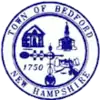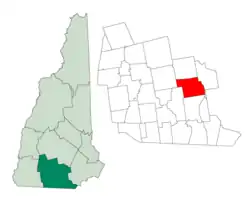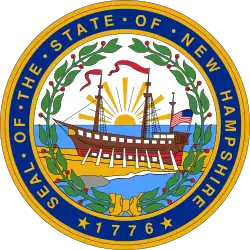Bedford, New Hampshire
Bedford is a town in Hillsborough County, New Hampshire, United States. The population was 21,203 at the 2010 census[2] and an estimated 22,628 in 2019.[3] Bedford is a suburb of Manchester, New Hampshire's largest city.
Bedford, New Hampshire | |
|---|---|
Town | |
 Town Hall | |
 Seal | |
 Location in Hillsborough County, New Hampshire | |
| Coordinates: 42°56′47″N 71°30′57″W | |
| Country | United States |
| State | New Hampshire |
| County | Hillsborough |
| Incorporated | 1750 |
| Government | |
| • Town Council | Bill Duschatko, Chair Melissa Stevens Lori Radke Denise Ricciardi David Gilbert William Carter Phil Greazzo |
| • Town Manager | Rick Sawyer[1] |
| Area | |
| • Total | 33.1 sq mi (85.8 km2) |
| • Land | 32.8 sq mi (85.0 km2) |
| • Water | 0.3 sq mi (0.7 km2) 0.88% |
| Elevation | 308 ft (94 m) |
| Population (2010) | |
| • Total | 21,203 |
| • Density | 646/sq mi (249.4/km2) |
| Time zone | UTC−5 (Eastern) |
| • Summer (DST) | UTC−4 (Eastern) |
| ZIP code | 03110 |
| Area code | 603 |
| FIPS code | 33-011-04500 |
| GNIS feature ID | 0873541 |
| Website | www |
History
In 1733, Massachusetts established Bedford as "Narragansett, No. 5" for the benefit of soldiers who fought against the Narragansett people in Rhode Island.[4] The area was also known as "Souhegan East". The settlement was incorporated as "Bedford" in 1750,[5] and was named for John Russell, 4th Duke of Bedford.[6] Lord Russell, a close friend of Governor Benning Wentworth, was the Secretary of State for the Southern Department from 1748 to 1751, and his first wife, Diana Spencer, was cousin to the influential Duke of Marlborough.[7]
The first English settlers in Bedford were Robert and James Walker III. A monument dated 1737 stands on what is now known as Station Road (adjacent to Hawthorne Drive), marking the first settlement. Bedford's first moderator was Mayor John Goffe, son of the Colonel John Goffe after whom Goffstown was named.[8]
In 1874, Bedford was served by Concord Railroad, and service by the Manchester and Ashburnham Railroad was being planned.[9]
Like much of southeastern New Hampshire, Bedford grew rapidly in the second half of the 20th century. The 2000 population of 18,274 was over eight times the population in 1950 of 2,176. Every decade in that period had a substantial rate of growth, ranging from 33 percent between 1980 and 1990 to a 67 percent increase between 1950 and 1960. As of 2017, Bedford was the 12th largest municipality in the state, with an estimated population of 22,458.[3]
Geography
According to the United States Census Bureau, the town has a total area of 33.1 square miles (86 km2), of which 32.8 sq mi (85 km2) are land and 0.3 sq mi (0.78 km2) are water, comprising 0.88% of the town. The largest body of water other than the Merrimack River is Sebbins Pond, which is connected to smaller, neighboring bodies of water by Sebbins Brook.
A rock formation called Pulpit Rock (originally the Devil's Pulpit) is located in the northwest part of the town on New Boston Road and is the feature of the town-owned Pulpit Rock Conservation Area. The highest point in Bedford is Holbrook Hill, at 845 feet (258 m) above sea level, located in the extreme northwest corner of town. Bedford lies fully within the Merrimack River watershed.[10]
Adjacent municipalities
- Goffstown, New Hampshire (north)
- Manchester, New Hampshire (east)
- Merrimack, New Hampshire (south)
- Amherst, New Hampshire (southwest)
- New Boston, New Hampshire (west)
Transportation
Two major highways run through Bedford. The Everett Turnpike runs north-south, and Route 101 runs east-west. The segment of the Everett Turnpike north of NH 101 and the segment of NH 101 east of the Everett Turnpike are designated Interstate 293; I-293 turns at this interchange.
The portion of Route 101 in eastern Bedford is a freeway, while the majority of the route through Bedford and to the west is a surface road. US 3 and Route 114 also run through Bedford.
Manchester-Boston Regional Airport is one town away, in Manchester.
Government and politics
Bedford is part of New Hampshire's 1st congressional district, currently represented by Democrat Chris Pappas. Bedford is part of the Executive Council of New Hampshire's 4th district, currently represented by Republican Ted Gatsas. In the State Senate, Bedford is part of New Hampshire's 9th State Senate district, currently represented by Democrat Jeanne Dietsch.
Bedford has long been a Republican stronghold in New Hampshire, voting for the Republican presidential nominee as far back as records are available. In 2020, the Republican winning streak in Bedford was finally broken as Democrat Joe Biden won the town with 51% of the vote.
Bedford was one of only four towns in New Hampshire where Democrats backed Hillary Rodham Clinton both times she sought the Democratic nomination for president in both 2008 and 2016.
| Year | Democratic | Republican | Third parties |
|---|---|---|---|
| 2020 | 51.0% 7,521 | 47.8% 7,052 | 1.1% 166 |
| 2016 | 44.1% 5,851 | 51.4% 6,816 | 4.4% 600 |
| 2012 | 36.7% 4,713 | 62.3% 7,990 | 0.9% 114 |
| 2008 | 40.5% 5,115 | 59.2% 7,442 | 0.6% 61 |
| 2004 | 37.1% 4,047 | 62.6% 6,836 | 0.3% 37 |
| 2000 | 35.3% 3,624 | 62.2% 6,381 | 2.5% 256 |
| 1996 | 37.8% 3,064 | 55.1% 4,467 | 6.7% 573 |
| 1992 | 27.8% 2,251 | 51.3% 4,145 | 20.8% 1,685 |
| 1988 | 22.0% 1,499 | 77.0% 5,237 | 1.0% 69 |
| 1984 | 19.4% 1,034 | 80.4% 4,294 | 0.3% 13 |
| 1980 | 17.9% 853 | 71.3% 3,400 | 10.8% 513 |
| 1976 | 31.7% 1,059 | 67.1% 2,240 | 1.0% 34 |
| 1972 | 21.1% 655 | 75.9% 2,360 | 3.1% 96 |
Demographics
| Historical population | |||
|---|---|---|---|
| Census | Pop. | %± | |
| 1790 | 898 | — | |
| 1800 | 1,182 | 31.6% | |
| 1810 | 1,296 | 9.6% | |
| 1820 | 1,375 | 6.1% | |
| 1830 | 1,554 | 13.0% | |
| 1840 | 1,549 | −0.3% | |
| 1850 | 1,914 | 23.6% | |
| 1860 | 1,172 | −38.8% | |
| 1870 | 1,221 | 4.2% | |
| 1880 | 1,204 | −1.4% | |
| 1890 | 1,102 | −8.5% | |
| 1900 | 1,148 | 4.2% | |
| 1910 | 1,110 | −3.3% | |
| 1920 | 1,118 | 0.7% | |
| 1930 | 1,326 | 18.6% | |
| 1940 | 1,561 | 17.7% | |
| 1950 | 2,176 | 39.4% | |
| 1960 | 3,636 | 67.1% | |
| 1970 | 5,859 | 61.1% | |
| 1980 | 9,481 | 61.8% | |
| 1990 | 12,563 | 32.5% | |
| 2000 | 18,274 | 45.5% | |
| 2010 | 21,203 | 16.0% | |
| 2017 (est.) | 22,458 | [3] | 5.9% |
| U.S. Decennial Census | |||
As of the census of 2010, there were 21,203 people, 7,364 households, and 5,834 families residing in the town. The population density was 646.4 people per square mile (249.4/km2). There were 7,634 housing units at an average density of 232.7 per square mile (89.8/km2). The racial makeup of the town was 94.5% White, 0.6% African American, 0.1% Native American, 2.9% Asian, 0.01% Pacific Islander, 0.4% from some other race, and 1.4% from two or more races. Hispanic or Latino of any race were 1.7% of the population.
There were 7,364 households, out of which 40.9% had children under the age of 18 living with them, 69.8% were headed by married couples living together, 6.5% had a female householder with no husband present, and 20.8% were non-families. 16.5% of all households were made up of individuals, and 7.6% were someone living alone who was 65 years of age or older. The average household size was 2.81 and the average family size was 3.19.
In the town, the age distribution of the population shows 28.6% under the age of 18, 4.7% from 18 to 24, 21.4% from 25 to 44, 31.7% from 45 to 64, and 13.5% who were 65 years of age or older. The median age was 42.3 years. For every 100 females, there were 95.7 males. For every 100 females age 18 and over, there were 92.1 males.[12]
For the period 2006–2010, the median income for a household in the town was $116,299 (in 2010 dollars), and the median income for a family was $127,589. Full-time male workers had median earnings of $99,366 versus $53,286 for females. The per capita income for the town was $50,952. About 2.7% of families and 3.4% of the population were below the poverty line, including 4.2% of those under age 18 and 1.0% of those age 65 or over.[13] Bedford had the fifth highest average personal income in the state between 2006 and 2010.[14]
Education
There are six schools in Bedford: Memorial (National Blue Ribbon School awardee in 2012), Peter Woodbury, and Riddle Brook (National Blue Ribbon School awardee in 2017) are neighborhood elementary schools that serve grades K through 4. McKelvie Intermediate School accommodates grades 5 and 6. Ross A. Lurgio Middle School and Bedford High School have served grades 7-8 and 9-12, respectively, since their establishment in 2007.
Ross A. Lurgio Middle School and Bedford High School comprise one 300,000 sq ft (28,000 m2) building. The unified construction aimed to take advantage of economies of scale by allowing the schools to share a kitchen, an auditorium, and security guards, but they operate as separate schools with different entrances, bus schedules, start times and end times. Additionally, key-controlled access is required to move between schools.
A small number of athletic fields on the campus of Saint Anselm College are located in Bedford.
Notable people
- Silas Aiken (1799–1869), minister and author[15]
- David Atwood (1815–1889), newspaperman and U.S. congressman from Wisconsin; born in Bedford[16]
- Chris Carpenter (1975-), pitcher with the St. Louis Cardinals[17]
- Zachariah Chandler (1813-1879), U.S. Secretary of the Interior 1875-77 and U.S. senator from Michigan; born in Bedford[18]
- John Goffe (1701-1786), colonial soldier[19]
- Carrie Jones (1982–), bestselling author of young adult novels; born in Bedford[20]
- Dean Kamen (1951-), inventor of the Segway HT and the iBOT; owner of Manchester-based DEKA Corporation[21]
- Grant Lavigne (1999-), minor-league baseball player in the Colorado Rockies system
- Josh Meyers (1976-), actor and comedian[22]
- Seth Meyers (1973-), comedian and talk-show host (Saturday Night Live, Late Night with Seth Meyers)[23]
- Mace Moulton, U.S. congressman 1845-1847 (D, NH-AL)[24]
- Rand Pecknold (1967-), Quinnipiac men's ice hockey coach and 500-game winner in NCAA ice hockey
- Patricia Racette (1965-), opera singer[25]
- Laura Silverman (1966-), actress[26]
- Sarah Silverman (1970-), comedian[27]
- John E. Sununu (1964-), Republican U.S. senator (2003–09); older brother of current New Hampshire governor Chris Sununu[28]
- Peter Woodbury (1899-1970), judge of the United States Court of Appeals for the First Circuit[29]
See also
- 1993 Little League World Series, when a team from Bedford advanced to the semi-finals
References
- "Town Manager". Town of Bedford. Retrieved July 28, 2020.
- "Geographic Identifiers: 2010 Census Summary File 1 (G001), Bedford town, Hillsborough County, New Hampshire". American FactFinder. U.S. Census Bureau. Archived from the original on February 13, 2020. Retrieved April 30, 2019.
- "Annual Estimates of the Resident Population: April 1, 2010 to July 1, 2017 (PEPANNRES): Minor Civil Divisions – New Hampshire". Archived from the original on February 13, 2020. Retrieved November 15, 2018.
- "Bedford". Statistics and Gazetteer of New-Hampshire, 1875. Retrieved December 19, 2013.
- "Bedford, New Hampshire". City-Data.com. Retrieved December 19, 2013.
- "Profile for Bedford, New Hampshire, NH". ePodunk. Archived from the original on October 16, 2014. Retrieved December 19, 2013.
- Laybourn, Keith (2001). British Political Leaders: A Biographical Dictionary. Keith. p. 29. ISBN 9781576070437.
- Coolidge, Austin Jacobs; Mansfield, John Brainard (1859). A History and Description of New England, General and Local. Boston: A.J. Coolidge. pp. 502–504.
- "Bedford". Statistics and Gazetteer of New-Hampshire, 1875. Retrieved December 19, 2013.
- Foster, Debra H.; Batorfalvy, Tatianna N.; Medalie, Laura (1995). Water Use in New Hampshire: An Activities Guide for Teachers. U.S. Department of the Interior and U.S. Geological Survey.
- "Election Results". sos.nh.gov.
- "Profile of General Population and Housing Characteristics: 2010 Demographic Profile Data, Bedford town, Hillsborough County, New Hampshire (DP-1)". American Factfinder. U.S. Census Bureau. Archived from the original on 2020-02-12. Retrieved 2012-11-27.
- "SELECTED ECONOMIC CHARACTERISTICS: 2006–2010 American Community Survey 5-Year Estimates (DP-3) – Bedford town, Hillsborough County, New Hampshire (DP-3)". American Factfinder. U.S. Census Bureau. Archived from the original on 2020-02-12. Retrieved 2012-11-27.
- "SELECTED ECONOMIC CHARACTERISTICS: 2006–2010 American Community Survey 5-Year Estimates (DP-3) – All Towns, New Hampshire". American Factfinder. U.S. Census Bureau. Archived from the original on 2020-02-12. Retrieved 2012-11-27.
- Kingsbury, John Dennison (1870). Sketch of Rev. Silas Aiken. Welch, Bigelow and Company. p. 3.
- "ATWOOD, David (1815 - 1889)". Biographical Directory of the United States Congress. United States Congress. Retrieved February 21, 2018.
- "Chris Carpenter". New Hampshire.com. Retrieved December 19, 2013.
- "Zachariah Chandler - American politician". britannica.com. Retrieved 26 March 2018.
- Daughters of the American Revolution (1905). Lineage Book – National Society of the Daughters of the American Revolution, Volume 19. Daughters of the American Revolution. p. 225.
- "An Interview with Carrie Jones". The Fictionistas. September 25, 2008. Retrieved February 21, 2018.
- "Dean Kamen's House Rivals Best Industrial Museums". Design News. Retrieved December 19, 2013.
- "For Seth Meyers, you can go home again". Bedford Journal. Archived from the original on 2012-05-23. Retrieved December 19, 2013.
- Dobbs, Katelyn. "For Seth Meyers, you can go home again". Bedford Journal. Archived from the original on 2012-05-23. Retrieved 2012-07-14.
- "Biography of HON. MACE MOULTON of Manchester NH". GENEALOGY AND HISTORY OF MANCHESTER NEW HAMPSHIRE TRANSCRIBED BY JANICE BROWN. Retrieved December 19, 2013.
- "A Soprano's Hat Trick: Puccini Triple Bill". The New York Times. Retrieved December 19, 2013.
- "Hollywood sisters say farewell to Granite State roots - New Hampshire". newhampshire.com. Retrieved 26 March 2018.
- Willis, John and Monush, Barry (2010). Screen World 2006. Hal Leonard Corporation. p. 404. ISBN 9781557837295.
- "Candidate Profile from Congressional Quarterly: John E. Sununu (R) of Bedford". CNN.com. Retrieved February 21, 2018.
- "Woodbury, Peter". Biographical Directory of Article III Federal Judges, 1789-present. Federal Judicial Center. Retrieved February 21, 2018.
External links
| Wikimedia Commons has media related to Bedford, New Hampshire. |
- Official website
- Bedford Historical Society
- New Hampshire Economic and Labor Market Information Bureau Profile

